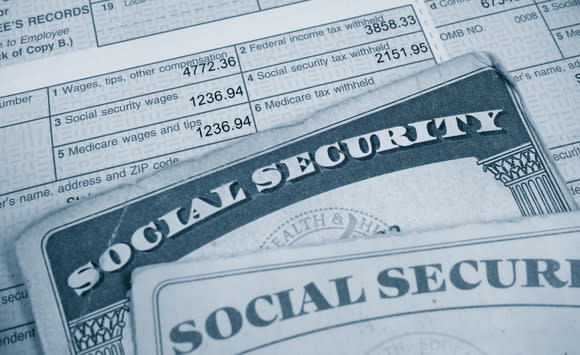The Rich Will Owe This Much Social Security Tax in 2019
This has been a big month for Social Security and its more than 62 million recipients. On Oct. 11, 2018, the Bureau of Labor Statistics (BLS) released its September inflation data, which provided the Social Security Administration (SSA) with the final data point needed to calculate the 2019 cost-of-living adjustment, or COLA. Think of COLA as the "raise" that beneficiaries receive from one year to the next.
The result, thanks to higher energy and shelter prices, is a healthy 2.8% increase in benefits for 2019, which marks the largest bump since 2012. Considering that Medicare Part B premiums are only rising by a little over 1%, this should result in a genuinely higher net payout for a majority of beneficiaries next year.

Image source: Getty Images.
An introduction to Social Security's payroll tax
However, the annual COLA release is just one of many data points that gets adjusted each year by the SSA. In addition to the 2019 COLA, the SSA also announced changes to the payroll tax earnings cap for the following year. In essence, it means wealthier workers will be paying more into the Social Security program in 2019.
Of the three funding sources for Social Security -- the payroll tax, interest income on its asset reserves, and the taxation of benefits -- the 12.4% payroll tax on earned income unquestionably does the heavy lifting. Last year, $873.6 billion of the $996.6 billion in revenue collected for the program was generated by the payroll tax on earned income.
But the interesting thing about Social Security's 12.4% payroll tax is that not all income is subject to it. In 2018, earned income up to $128,400 is subject to the payroll tax, with any earnings above this amount exempted. This allows a small percentage of working Americans (less than 1 in 10) to escape paying into Social Security with some, or most, of their income, depending on their earnings.
Why not apply the payroll tax to all income? The straightforward answer is because the SSA also caps the maximum retirement benefit at full retirement age each year. In 2018, regardless of whether you average $150,000 in income a year during your lifetime or $10 million annually, your maximum retirement benefit at full retirement age is $2,788 a month. Since there's a cap on what an individual can be paid from Social Security at full retirement age, there's also a cap on what amount of earned income is taxable by Social Security's payroll tax.

Image source: Getty Images.
Here's why the rich will owe more Social Security tax in 2019
Assuming COLA is positive -- the earnings cap remains unchanged in years when no COLA is passed along -- the payroll tax cap is increased on par with the National Average Wage Index (NAWI). With the NAWI having risen 3.45% in 2017 ($48,642.15 in 2016 to $50,321.89 in 2017), the payroll tax cap will increase by 3.5%, when rounded to the nearest 0.1%, in 2019. This works out to a new cap of $132,900 next year, up from $128,400 in 2018. This means that the less than 1 in 10 rich workers earning above $128,400 will have to pay more into the program next year.
Of course, there is a difference between being a well-to-do employee and being self-employed. Regardless of how much you earn each year, if you're employed by someone else, your employer will cover half of your Social Security payroll tax liability up to the cap ($132,900 in 2019). Rather than paying 12.4%, you as an employee would owe 6.2%, with your employer picking up the other half. Thus, if we're talking about a well-to-do employee, he or she could owe a maximum of $8,239.80 in 2019, or up to $279 more than they paid in 2018.
If you're self-employed, you can expect a bigger bite out of your pocket. That's because the self-employed are responsible for the full 12.4% Social Security tax up to $132,900. Next year that'll work out to $16,479.60, or $558 more than in 2018, assuming a self-employed worker hit the cap in both years.

Image source: Getty Images.
A lot of income is currently escaping taxation
Despite this increase in the payroll tax cap, it's worth pointing out that a lot of earned income escapes taxation each year.
According to data from the SSA, approximately $300 billion in earnings escaped taxation (i.e., was above the taxable cap) back in 1983. However, this figure had quadrupled to $1.2 trillion by 2016. Even with annual increases to the tax cap that are commensurate with average wage growth, the rich are seeing their money grow at a substantially quicker pace, thereby allowing more income to escape taxation.
Now, here's where things get interesting. If the cap were removed completely and, like Medicare, all earned income were exposed to program taxation, then it would almost certainly erase the $13.2 trillion cash shortfall Social Security is facing between 2034 and 2092. The reason the cap hasn't been increased substantially to ensure that less income escapes taxation has to do with the aforementioned cap on monthly payouts at full retirement age, as well as the inability of Republicans and Democrats to agree on an amicable solution to the program's cash shortfall.
In other words, even though the cap is rising, more income than ever is likely to escape Social Security's payroll tax.
More From The Motley Fool
The Motley Fool has a disclosure policy.
